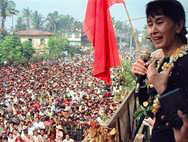Burma: Aung San Suu Kyi and the Non-violent Struggle for Democracy in Burma
1988 to Present[edit]
After living most of her life in Oxford, United Kingdom, Aung San Suu Kyi left her husband and family and returned to Burma in 1988 with only the intention of taking care of her aging mother. The daughter of the Burmese national hero General Aung San, Suu Kyi found herself catapulted from a quiet life in Oxford to becoming the leading voice of the pro-democracy Burmese opposition to dismantle a twenty-six year dictatorship, which called for a multiparty democracy and national unity through nonviolent means.
In the 1990 elections, Aung San Suu Kyi’s party, the National League for Democracy (NLD), won the parliamentary elections by a landslide victory. However, the military-led government ignored the results and arrested the NLD leadership, enforcing decades of exile, prison terms, or house arrest, which included15 years of house arrest for Augn San Suu Kyi.
Despite what has reported to be intense and brutal oppression, non-violent political opposition persisted in Burma. This includes the Saffron Revolution in September 2007, where protests led by Buddhist monks grew to over 100,000 people in less than a week.
Burmese youth quickly utilized social media to internationalise the Burmese struggle. In response to immense public pressure, the Burmese government opened dialogue with Aung San Suu Kyi, and in 2010 she was finally released from house arrest. While the Burmese struggle for democracy is far from over, in 2012 Aung San Suu Kyi was elected to the Burmese parliament and has been allowed to take her position in office. Burma is finally taking steps toward democracy.
